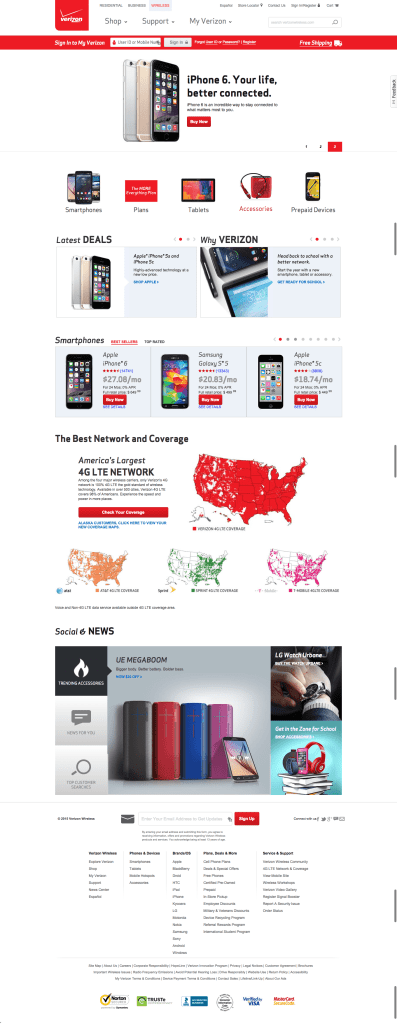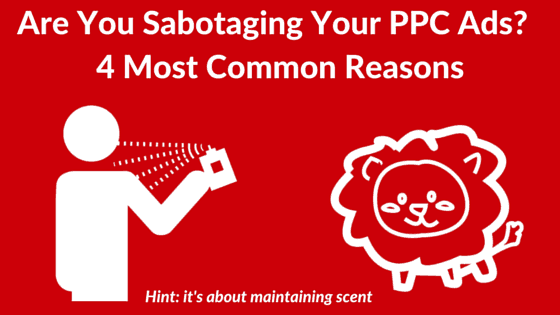
In my last post I showed you the #1 thing impacting the conversion rate of your website: your value proposition.
Today I’m going to show you another valuable way to ensure you are maximizing your opportunity to increase conversions on your website: relevancy.
I’ll show you how to increase relevancy by optimizing these four elements:
- Headline match
- Sub-headline match
- Image match
- URL of landing page relevant to keyword
But first, let me take a minute to explain a conversion.
A conversion is transforming X into Y. A website visitor into a buyer or a lead. Or other things.
You calculate the conversion rate by doing the following:
The goal being whatever it is you want the visitor to do on your website or landing page (download white paper, sign up for newsletter, buy your product or learn how to create a compelling call to action).
In this post, we’re going to be making sure your ad campaigns are properly aligned with your offer by optimizing for relevancy.
Here’s a quick video of me trying to find landing pages relevant to their ads being shown on Google and Facebook:
Not very successful was I? Which is why it’s super important for you to have a match between your ads and your destination page.
By doing so you will not only meet and exceed your campaign objectives, you will increase your conversion rate.
You do want that, right? 🙂
Never Start A Marketing Campaign Without a Dedicated Landing Page
Please ingrain this into your noggin:
Never Start A Marketing Campaign Without a Dedicated Landing Page
Got it? Good.
Whether you are promoting a product, your service, a giveaway or doing a radio spot, make sure you have a dedicated landing page in place before starting the campaign.
Why?
Because you want to increase the opportunity of getting the conversion.
If you send visitors from your PPC (Pay Per Click) campaign to your homepage, your ad’s relevancy will decrease because the ad won’t match the homepage and the homepage will have multiple links to distract the user from your goal.
For example, if you were Verizon and were sending paid clicks to the homepage, do you think visitors would be distracted by all the images, links, and offers shown in the image below?
Visitors would have no idea where to click on this homepage.
This is why you must maintain relevancy.
Or as I like to say: maintain scent trail.
Your Prospects Are Like Animals
Let me explain.
Your prospects are like animals on the hunt for prey.
The location of the hunt takes place on a search engine. It’s at this time when your prospective customers are engaged in a focused search with a particular need in mind.
They are foraging to identify the information and products they need.
It’s your job to provide a strong scent trail to keep prospects engaged until they’re satisfied they have found the information they seek (captured their prey).
For example, let’s say you’re foraging for a good deal on a new set of tires. You open up your browser and do a Google search for cheap tires.
On nearly every search, you see ads at the top and to the right side of your search results.
Like this:
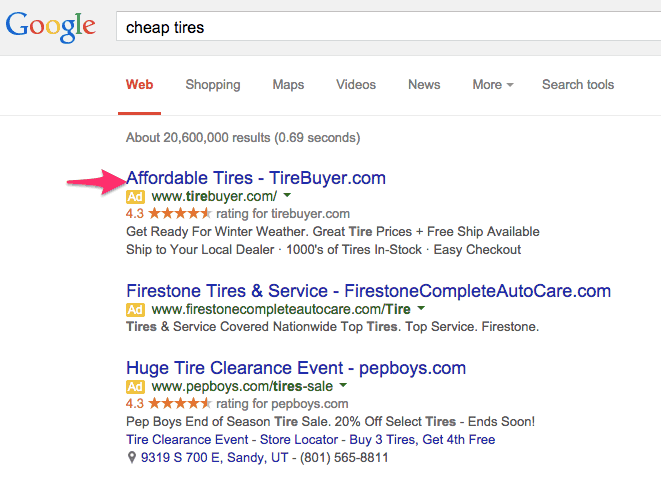
The search for “cheap tires” displays a list of businesses selling cheap (or affordable) tires. Naturally then, if I were to click on the first result of the ad results from Tire Buyer, I should expect to see a list of cheap (or affordable) tires.
Let’s see what happened:
 Oh, not what I was expecting at all! Instead, it shows an award for the “Circle of Excellence Platinum 2014”.
Oh, not what I was expecting at all! Instead, it shows an award for the “Circle of Excellence Platinum 2014”.
That has nothing to do with tires does it?
The scent trail was lost and you go back to foraging for a set of affordable tires.
And you know what?
Soooo many businesses, bloggers, and agencies make this mistake. And it’s an easy fix!
Perhaps you’re thinking it doesn’t matter much to have relevancy with your ad campaigns.
Au contraire, mon frere!
Think about this:
Higher relevancy = higher click-through rate = higher Quality Score = lower cost per click = lower cost per conversion.
Which equals a better ROI (Return on Investment) with your advertising dollars.
Have you never run an ad campaign?
I recommend you give it a try. You can connect with searchers actively looking for products and services like yours and respond to that need by providing them with a relevant offer.
It’s also a cost-effective (see my relevancy equation above) way to generate leads by reaching people who are searching to buy.
How to Maintain Scent in Your Ad Campaigns
It doesn’t take long to increase the relevancy of your ads.
In fact, I’m going to show you how you can fix your campaigns in about 15 minutes. And if you don’t have any active campaigns, save this article for when you are ready to run your campaign so you don’t make the same mistake Tire Buyer made above.
Let’s get started.
Step 1: Log into your advertising account
Log in to the appropriate account (Google AdWords, Bing Ads or Facebook Ads), from which you are running your campaign. Once there, navigate to the ad currently running.
Here is what mine looks like inside Google AdWords:
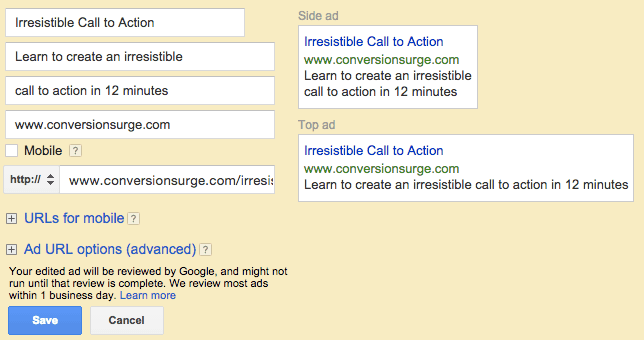
Step 2: Review the headline and compare to your landing page
Read the headline and subheadline of your ad. Now read the headline and subheadline of your landing page.
Do they match?
For example, here is the headline of my ad compared to the headline of the landing page.
It’s not a word for word match because there is a character limit in AdWords but it nails the essential keyword of my headline.
Step 3: Look at the image of your ad (if using Facebook or any other ad image service).
Does the image of your ad match the image of your landing page? If not, change it to match.
For example, here is the image of a recent Facebook ad campaign I ran compared to the image on the landing page.

Facebook has a text limit for their ads so I could only match the images.
Step 4: Check the URL of your landing page
In your ad account, review the URL you are sending visitors to. Does it contain the keyword from your ad?
For example, let’s say I am running an ad to promote my new airport shuttle service for the Park City, Utah area.
Then I would send people to a URL that had something like this: www.parkcitytransportation.com/airportshuttle
And on the landing page I would only talk about the benefits of booking my airport shuttle to/from Park City over other transportation services.
And give them ONE call to action: book the shuttle.
Like this:
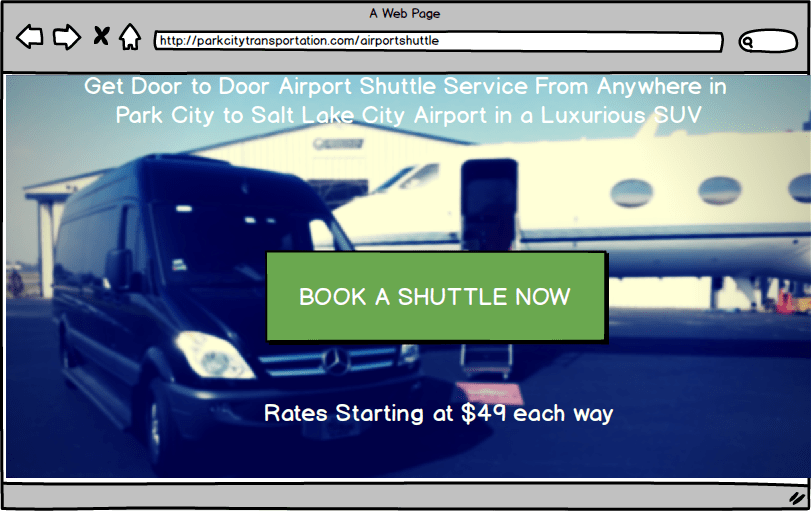 Why only one action on the landing page?
Why only one action on the landing page?
Look, this might seem counterintuitive, but the single goal of your landing page is to have someone take your call to action or leave. That’s it.
A landing page is not the time to go into “About Us” or “Our Mission Statement”, it’s the time to convert a prospect to a lead.
If you provide them with any more choices (like the Verizon example above), they will get distracted and forget about your offer.
Follow these four steps and you’re on your way to higher conversions.
Humans Are Really Good at Matching Patterns
But you already knew this, right?
We are constantly checking to see if we are on the right path (or scent trail) when we are searching for things online by following patterns.
Allow me to make an analogy with a Google search.
I don’t speak, nor read, Russian. But the language is written in Cyrillic, which to a person like me, represents symbols.
For example, где туалет is Russian for “where’s the toilet?”
If I enter this phrase into Google, here’s what I get.
 By using a pattern-matching mental process, I can discern which of these search results have the phrase “где туалет” and click on the ones relevant to my search.
By using a pattern-matching mental process, I can discern which of these search results have the phrase “где туалет” and click on the ones relevant to my search.
Optimize These Elements for Relevancy
In summary, by ensuring the following elements are optimized for relevancy, you’ll have a higher chance of the prospect taking your call to action:
- Headline
- Sub-headline
- Image match
- URL of landing page
And you will be maintaining the scent so your hunter will capture its prey (much like the cheetah above).


